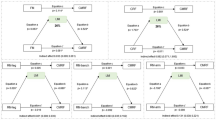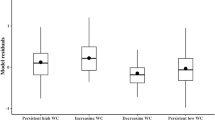Abstract
The aims of this study were to examine the longitudinal association between muscular fitness (MF) and blood pressure (BP) 2 years later, and to determine whether changes in MF over a 2-year period were associated with BP at follow-up, in adolescents. The sample comprised 734 youths (349 girls) aged from 12 to 18 years. MF was assessed with the standing long jump and handgrip tests. Socioeconomic status, pubertal stage, waist circumference, resting BP, and cardiorespiratory fitness were measured according to standard procedures. Regression analyses showed a significant inverse association between MF at baseline and systolic BP (β = − 0.072; p = 0.032) and rate pressure product (β = − 0.124; p < 0.001) at follow-up, after adjustments for age, sex, height, pubertal stage, and socioeconomic status. However, when analyses were further adjusted for waist circumference and cardiorespiratory fitness, these associations did not remain significant. Adolescents with persistently high and increasing MF exhibited the lowest levels of diastolic BP (F(3, 721) = 3.814, p = 0.018) and systolic BP (F(3, 721) = 3.908, p = 0.014) when compared to those with persistent low MF after adjustment for age, sex, height, socioeconomic status, cardiorespiratory fitness, and waist circumference.
Conclusion: This study suggests that persistent greater and increasing MF in youth are associated with lower levels of BP across the adolescence.
What is Known: | |
• Currently, there is a growing interest on the health benefits of muscular fitness. | |
• Cross-sectional studies have identified an association between muscular fitness and blood pressure in adolescents. | |
What is New: | |
• Changes in muscular fitness during adolescence were associated with systolic and diastolic BP over a 2-year period. | |
• Adolescents with persistently low muscular fitness exhibited the highest levels of diastolic and systolic BP. |


Similar content being viewed by others
Abbreviations
- BP:
-
Blood pressure
- CRF:
-
Cardiorespiratory fitness
- MF:
-
Muscular fitness
- SD:
-
Standard deviation
References
Agostinis-Sobrinho C, Santos R, Moreira C, Abreu S, Lopes L, Oliveira-Santos J, Rosário R, Póvoas S, Mota J (2016) Association between serum adiponectin levels and muscular fitness in Portuguese adolescents: LabMed Physical Activity Study. Nutr Metab Cardiovasc Dis 26(6):517–524. https://doi.org/10.1016/j.numecd.2016.02.011
Agostinis-Sobrinho CA, Moreira C, Abreu S, Lopes L, Sardinha LB, Oliveira-Santos J, Oliveira A, Mota J, Santos R (2017) Muscular fitness and metabolic and inflammatory biomarkers in adolescents: results from LabMed Physical Activity Study. Scand J Med Sci Sports 27(12):1873–1880. https://doi.org/10.1111/sms.12805
Agostinis-Sobrinho CA, Ramirez-Velez R, Garcia-Hermoso A et al (2017) Low-grade inflammation and muscular fitness on insulin resistance in adolescents: results from LabMed Physical Activity Study. Pediatr Diabetes 19:429–435. https://doi.org/10.1111/pedi.12607
Agostinis-Sobrinho C, Abreu S, Moreira C, Lopes L, García-Hermoso A, Ramírez-Vélez R, Correa-Bautista JE, Mota J, Santos R (2017) Muscular fitness, adherence to the Southern European Atlantic Diet and cardiometabolic risk factors in adolescents. Nutr Metab Cardiovasc Dis 27(8):695–702. https://doi.org/10.1016/j.numecd.2017.04.008
Agostinis-Sobrinho C, Ruiz JR, Moreira C, Abreu S, Lopes L, Oliveira-Santos J, Mota J, Santos R (2018) Cardiorespiratory fitness and blood pressure: a longitudinal analysis. J Pediatr 192:130–135. https://doi.org/10.1016/j.jpeds.2017.09.055
Agostinis-Sobrinho C, Brand C, Moreira C, Lopes L, Oliveira-santos J, Silva P, Reis Gaya A, Gaya A, Mota J, Santos R, Abreu S (2018) Muscular fitness, Southern European Atlantic Diet and inflammation in adolescents. Azorean Physical Activity and Health Study II. Eur J Sports Sci 18(1):104–111. https://doi.org/10.1080/17461391.2017.1394368
Artero EG, Ruiz JR, Ortega FB, España-Romero V, Vicente-Rodríguez G, Molnar D, Gottrand F, González-Gross M, Breidenassel C, Moreno LA, Gutiérrez A, on behalf of the HELENA Study Group (2011) Muscular and cardiorespiratory fitness are independently associated with metabolic risk in adolescents: the HELENA study. Pediatr Diabetes 12:704–712. https://doi.org/10.1111/j.1399-5448.2011.00769.x
Artero EG, Lee D, Lavie CJ, España-Romero V, Sui X, Church TS, Blair SN (2012) Effects of muscular strength on cardiovascular risk factors and prognosis. J Cardiopulm Rehabil Prev 32(6):351–358. https://doi.org/10.1097/HCR.0b013e3182642688
Ascenso A, Palmeira A, Pedro LM, Martins S, Fonseca H (2016) Physical activity and cardiorespiratory fitness, but not sedentary behavior, are associated with carotid intima-media thickness in obese adolescents. Eur J Pediatr 175(3):391–398. https://doi.org/10.1007/s00431-015-2654-x
Chen X, Wang Y, Chen X, YW CX, Wang Y (2008) Tracking of blood pressure from childhood to adulthood: a systematic review and meta-regression analysis. Circulation 117(25):3171–3180. https://doi.org/10.1161/CIRCULATIONAHA.107.730366.
Cohen DD, López-Jaramillo P, Santos F, Castro-Piñero J, Sandercock G. Muscle strength is associated with lower diastolic blood pressure in schoolchildren. Prev Med (Baltim). 2016;95:1–6. doi:https://doi.org/10.1016/j.ypmed.2016.11.006.
Cornelissen VA, Smart NA (2013) Exercise training for blood pressure: a systematic review and meta-analysis. J Am Heart Assoc 2(1):e004473. https://doi.org/10.1161/JAHA.112.004473
Currie C, Molcho M, Boyce W, Holstein B, Torsheim T, Richter M (2008) Researching health inequalities in adolescents: the development of the Health Behaviour in School-Aged Children (HBSC) Family Affluence Scale. Soc Sci Med 66:1429–1436. https://doi.org/10.1016/j.socscimed.2007.11.024
Faigenbaum AD, MacDonald JP. Dynapenia: it’s not just for grown-ups anymore. Acta Paediatr Int J Paediatr 2017;106(5):696–697. doi:https://doi.org/10.1111/apa.13797.
Fernandez I, Canet O, Gine-Garriga M (2017) Assessment of physical activity levels, fitness and perceived barriers to physical activity practice in adolescents: cross-sectional study. Eur J Pediatr 176(1):57–65. https://doi.org/10.1007/s00431-016-2809-4
Fraser BJ, Huynh QL, Schmidt MD, Dwyer T, Venn AJ, Magnussen CG (2016) Childhood muscular fitness phenotypes and adult metabolic syndrome. Med Sci Sports Exerc 48(9):1715–1722. https://doi.org/10.1249/MSS.0000000000000955
García-Hermoso A, Carrillo HA, González-Ruóz K et al (2017) Fatness mediates the influence of muscular fitness on metabolic syndrome in Colombian collegiate students. PLoS One 12(3):1–13. https://doi.org/10.1371/journal.pone.0173932.
Grontved A, Ried-Larsen M, Moller NC et al (2015) Muscle strength in youth and cardiovascular risk in young adulthood (the European Youth Heart Study). Br J Sports Med 49(2):90–94. https://doi.org/10.1136/bjsports-2012-091907
Janz KF, Dawson JD, Mahoney LT (2002) Increases in physical fitness during childhood improve cardiovascular health during adolescence: the Muscatine Study. Int J Sports Med 23(Suppl 1):S15–S21. https://doi.org/10.1055/s-2002-28456.
Jimenez Pavon D, Ortega FP, Ruiz JR et al (2010) Socioeconomic status influences physical fitness in European adolescents independently of body fat and physical activity: the HELENA study. Nutr Hosp 25(2):311–316
Jones MA, Hitchen PJ, Stratton G (2000) The importance of considering biological maturity when assessing physical fitness measures in girls and boys aged 10 to 16 years. Ann Hum Biol 27(1):57–65
Kelly RK, Thomson R, Smith KJ, Dwyer T, Venn A, Magnussen CG (2015) Factors affecting tracking of blood pressure from childhood to adulthood: the Childhood Determinants of Adult Health Study. J Pediatr 167(6):1422–1428.e2. https://doi.org/10.1016/j.jpeds.2015.07.055
Leger LA, Mercier D, Gadoury C, Lambert J (1988) The multistage 20 metre shuttle run test for aerobic fitness. J Sports Sci 6(2):93–101. https://doi.org/10.1080/02640418808729800
Leng B, Jin Y, Li G, Chen L, Jin N (2015) Socioeconomic status and hypertension: a meta-analysis. J Hypertens 33(2):221–229. https://doi.org/10.1097/HJH.0000000000000428
Lin CY, Chen PC, Kuo HK, Lin LY, Lin JW, Hwang JJ (2010) Effects of obesity, physical activity, and cardiorespiratory fitness on blood pressure, inflammation, and insulin resistance in the National Health and Nutrition Survey 1999–2002. Nutr Metab Cardiovasc Dis 20(10):713–719
Lurbe E, Agabiti-Rosei E, Cruickshank JK et al (2016) 2016 European Society of Hypertension guidelines for the management of high blood pressure in children and adolescents. J Hypertens 34(10):1887–1920. https://doi.org/10.1097/HJH.0000000000001039
McCrindle BW (2010) Assessment and management of hypertension in children and adolescents. Nat Rev Cardiol 7(3):155–163. https://doi.org/10.1038/nrcardio.2009.231
Naylor LH, Watts K, Sharpe JA et al (2008) Resistance training and diastolic myocardial tissue velocities in obese children. Med Sci Sports Exerc 40(12):2027–2032. https://doi.org/10.1249/MSS.0b013e318182a9e0
Ortega FB, Ruiz JR, Castillo MJ, Sjöström M (2008) Physical fitness in childhood and adolescence: a powerful marker of health. Int J Obes 32(1):1–11. https://doi.org/10.1038/sj.ijo.0803774
Ortega FB, Silventoinen K, Tynelius P, Rasmussen F (2012) Muscular strength in male adolescents and premature death: cohort study of one million participants. BMJ 345:e7279
Peterson MD, Saltarelli WA, Visich PS, Gordon PM (2014) Strength capacity and cardiometabolic risk clustering in adolescents. Pediatrics 133(4):e896–e903. https://doi.org/10.1542/peds.2013-3169
Ramírez-vélez R, Tordecilla-sanders A, Correa-bautista JE, Peterson MD, Garcia-hermoso A (2016) Handgrip strength and ideal cardiovascular health among Colombian children and adolescents. J Pediatr 179:82–89.e1. https://doi.org/10.1016/j.jpeds.2016.08.099
Ruiz JR, España-Romero V, Ortega FB, Sjöström M, Castillo MJ, Gutierrez A (2006) Hand span influences optimal grip span in male and female teenagers. J Hand Surg Am 31(8):1367–1372. https://doi.org/10.1016/j.jhsa.2006.06.014
Ruiz JR, Castro-Piñero J, Artero EG et al (2009) Predictive validity of health-related fitness in youth: a systematic review. Br J Sports Med 43(12):909–923. https://doi.org/10.1136/bjsm.2008.056499
Ruiz JR, Castro-Piñero J, España-Romero V et al (2011) Field-based fitness assessment in young people: the ALPHA health-related fitness test battery for children and adolescents. Br J Sports Med 45:518–524
Ruiz JR, Cavero-Redondo I, Ortega FB, Welk GJ, Andersen LB, Martinez-Vizcaino V (2016) Cardiorespiratory fitness cut points to avoid cardiovascular disease risk in children and adolescents; what level of fitness should raise a red flag? A systematic review and meta-analysis. Br J Sports Med 50:1451–1458. https://doi.org/10.1136/bjsports-2015-095903
Seron BB, Goessler KF, Modesto EL, Almeida EW, Greguol M (2015) Blood pressure and hemodynamic adaptations after a training program in young individuals with Down syndrome. Arq Bras Cardiol:487–491. https://doi.org/10.5935/abc.20150033
Shankar RR, Eckert GJ, Saha C, Tu W, Pratt JH (2005) The change in blood pressure during pubertal growth. J Clin Endocrinol Metab 90(1):163–167. https://doi.org/10.1210/jc.2004-0926
Smith JJ, Eather N, Morgan PJ, Plotnikoff RC, Faigenbaum AD, Lubans DR (2014) The health benefits of muscular fitness for children and adolescents: a systematic review and meta-analysis. Sport Med 44:1209–1223. https://doi.org/10.1007/s40279-014-0196-4
Tanner JM, Whitehouse RH (1976) Clinical longitudinal standards for height, weight, height velocity, weight velocity, and stages of puberty. Arch Dis Child 51(3):170–179. https://doi.org/10.1136/adc.51.3.170
Volaklis KA, Halle M, Meisinger C (2015) Muscular strength as a strong predictor of mortality: a narrative review. Eur J Intern Med 26(5):303–310. https://doi.org/10.1016/j.ejim.2015.04.013
WHO | A global brief on hypertension. WHO. 2013. http://www.who.int/cardiovascular_diseases/publications/global_brief_hypertension/en/#.Wthx3TeEHMI.mendeley. Accessed April 19, 2018
Wind AE, Takken T, Helders PJ, Engelbert RH (2010) Is grip strength a predictor for total muscle strength in healthy children, adolescents, and young adults? Eur J Pediatr 169(3):281–287. https://doi.org/10.1007/s00431-009-1010-4
Acknowledgements
The authors gratefully acknowledged the participation of all adolescents and their parents, teachers, and schools of the LabMed Study. They also acknowledge the cooperation of volunteer’s subjects and the Research Centre in Physical Activity, Health and Leisure (University of Porto) for the sponsoring of the LabMed Study.
Funding source
This study was supported by FCT grant BD88984/2012. The first author was given Doctoral scholarship from Brazilian government by CAPES (Coordination of Improvement of Higher Education Personnel) (Proc: 9588-13-2). The Research Centre on Physical Activity Health and Leisure (CIAFEL) is supported by UID/DTP/00617/2013 (FCT). Rute Santos has a Discovery Early Career Research Award from the Australian Research Council (DE150101921).
Author information
Authors and Affiliations
Contributions
Drs. César Agostinis-Sobrinho and Rute Santos designed and carried out the initial analyses, drafted the initial manuscript and participated in data collection; Dr. Jonatan Ruiz participated in the study design, interpretation of data and revised the manuscript; Drs. Jorge Mota, Carla Moreira, and Luis Lopes participated in the study design and data collection, reviewed and data interpretation; Drs. Robinson Ramirez-Vélez and Antonio Garcia-Hermozo participated in analyzed the data and reviewed the manuscript; All authors approved the final manuscript as submitted.
Corresponding author
Ethics declarations
Conflict of interest
The authors declare that they have no conflict of interest.
Informed consent
Informed consent was obtained from all individual participants included in this study.
Additional information
Communicated by Mario Bianchetti
Rights and permissions
About this article
Cite this article
Agostinis-Sobrinho, C., Ruiz, J.R., Moreira, C. et al. Changes in muscular fitness and its association with blood pressure in adolescents. Eur J Pediatr 177, 1101–1109 (2018). https://doi.org/10.1007/s00431-018-3164-4
Received:
Revised:
Accepted:
Published:
Issue Date:
DOI: https://doi.org/10.1007/s00431-018-3164-4




